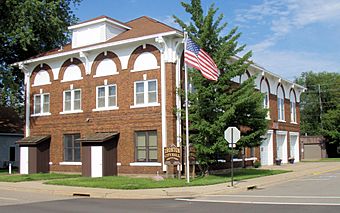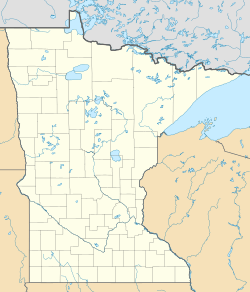Ironton City Hall facts for kids
Quick facts for kids |
|
|
Ironton City Hall
|
|

Ironton City Hall from the southwest
|
|
| Location | 309 3rd Street, Ironton, Minnesota |
|---|---|
| Built | 1917 |
| Architect | Alex Nelson |
| Architectural style | American Craftsman, Colonial Revival |
| NRHP reference No. | 02000637 |
| Designated | June 14, 2002 |
Ironton City Hall is a special old building in Ironton, Minnesota. It was built in 1917. This building was home to many important things for the city. It had offices, the fire department, a library, and even a jail. There was also a big room called an auditorium. Many groups and events used this space.
Ironton City Hall was added to the National Register of Historic Places in 2002. This means it's a very important historical site. It's recognized for its role in the city's government and social life. For a long time, it was the main place for Ironton's city services and community activities.
Contents
What Does Ironton City Hall Look Like?
Ironton City Hall is a two-story building. It's about 94 feet long and 46 feet wide. The main sides you see are to the west and south. There's a smaller, one-story part on the northeast side. This part used to be the jail.
A tall tower stands on the east side of the building. This tower is two and a half stories high. It was used to hang and dry the fire department's hoses.
Building Materials and Style
The building sits on a strong limestone foundation. The walls are made of colorful bricks. These bricks come in shades of red, brown, black, and orange. The roof is shaped like a hip roof. It has wide edges that stick out. These edges are held up by wooden brackets. There's also a small roof window, called a dormer, on the west side.
The west and south sides of the building have the most decorations. Fancy brickwork frames the windows and doors on the first floor. Two lines of special bricks separate the top and bottom floors. Bricks above the second-floor windows form flat arches. Above these, there used to be semicircular windows. These were covered with wood around 1980. The spaces inside the arches are covered with stucco. All the windows have wide limestone sills. The top two rows of windows also have white keystones. The large drainpipes on the corners were added in 1996.
Doors and Inside Spaces
There are three main entrances to the building. One is on the south side. The other two are on the west side. These two west entrances were covered with small additions around 1980. On the south side, there are three large garage doors. These doors were for the fire trucks.
Inside, the second floor used to have a large auditorium. It could hold many people and had a balcony. There was also a kitchen and two small rooms for reading.
How Ironton City Hall Started
The city of Ironton was planned out in 1910. This was when iron mining in the Cuyuna Range made the local economy grow fast. One of the city's founders, John H. Hill, had a big idea. He wanted Ironton to be a beautiful town. He imagined wide streets, public parks, and nice buildings. He hoped this would attract cultured families to the mining town.
Hill suggested building a city hall that could be used for many things. But the city council didn't approve his idea until 1916. In November of that year, the public voted. They strongly supported building the hall. They also agreed to borrow $20,000 to pay for it.
Finding a Spot and Building It
By this time, the busy town didn't have any empty land for the building. So, the city paid a small amount to the owners of three houses. They also paid to move these houses to other places. The chosen spot was next to Ironton's main business area. It was also across the street from the train station.
Four companies offered to build the hall in June 1917. The job went to Alex Nelson from Perham, Minnesota. Construction started the very next week. The building was finished and opened in December of that same year.
What Ironton City Hall Was Used For
When Ironton City Hall first opened, it had space for many important city services. It held city council meetings. It also housed the fire department and the city jail. The city's public library officially started in 1920. It quickly moved into the new city hall too.
Fire Department and Law Enforcement
The fire department had a room for their equipment. This room had three large garage doors. They also had a club room with lockers, showers, and fun things for firefighters. The department got its first motorized fire engine soon after the hall was built. Firefighters also helped maintain the building. They even used the basement as a gym. In 1920, the alarm bell on top of the hose tower was replaced with an electric siren. The garage doors were also changed to fit new, taller fire trucks.
Law enforcement was important in the mining town. One or two marshals worked out of the hall. The jail part of the building had four cells. This meant Ironton didn't have to send its prisoners to the nearby city of Crosby anymore. In fact, Ironton even started holding prisoners for nearby Deerwood.
Community Hub: The Auditorium
The auditorium on the second floor was a big space. It could hold up to 400 people. Community groups could rent this room for their events. If a group was raising money for charity, they got a discount. Many early events in the hall helped American soldiers in World War I or their families.
Many different groups used the auditorium. These included clubs, sports teams, and scout groups. The local high school also used it. Events ranged from plays and dances to concerts and craft fairs. There was even an indoor carnival once! The room was also used as a hospital during the 1918 flu pandemic.
Later Years of the City Hall
Over time, the need for police services in Ironton changed. This was because the mining industry slowed down. The Ironton police department closed in 1971. After that, another city handled law enforcement.
In 1993, the upper floor and basement of the city hall were closed. This was due to problems with accessibility. It was hard for everyone to use those parts of the building. In 1996, new, accessible restrooms were added on the first floor. This was part of a bigger renovation. The renovation also changed how the government offices and the library were set up.
When the building was nominated for the National Register in 2002, it was still very active. It housed the city council chambers, the county clerk's office, the children's library, and the fire department.



